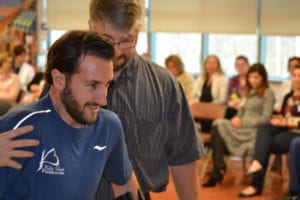By Anthony Petriello
St. Charles Hospital’s renowned rehabilitation department has a new second-in-command. Laura Beck, a current employee at the hospital and a Miller Place resident, was recently promoted to Vice President of Rehabilitation.
Beck will be responsible for overseeing both inpatient and outpatient rehabilitation for St. Charles as well as recently implemented programs geared toward sports medicine; treating lymphedema, a condition that leads to fluid build-up and swelling; and vestibular rehabilitation, an exercise-based program aimed at alleviating balance and gait issues.

Beck has been working at St. Charles in various positions for 26 years, and she received her Bachelor’s Degree in Physical Therapy from Quinnipiac College, which is now Quinnipiac University. Her first position as a physical therapist was at St. Charles, and she returned to college and received her Master’s degree in Healthcare Administration and Policy from Stony Brook University.
“I am very excited for the opportunity,” she said. “St. Charles has an extremely long history, over 110 years, of excellence in rehabilitation that I am very proud to be a part of, and I am very excited for the chance to further our program, continue to grow, and continue the tradition of rehab we have had here for so many years.”
Beck has had served in many roles in her tenure at St. Charles. She started out as a staff physical therapist in 1991 and was promoted to a senior level physical therapist in 1994. Two years later Beck was promoted once again to supervising physical therapist, overseeing other therapists while still seeing patients herself. Beck started her focus on outpatient rehabilitation in 2000, when she was promoted to center manager of the Port Jefferson outpatient office.
Acknowledging her knowledge and acumen in rehabilitation, the hospital promoted her to director of Outpatient Rehabilitation, Pediatric Rehabilitation Services, and Offsite Contracts in 2003. In that position, which she held until just recently, she oversaw the daily activities of all nine of St. Charles’ outpatient rehabilitation locations across Long Island, which treat more than 10,000 patients every year, according to the hospital’s website.
Jim O’Connor, the executive vice president and chief administrative officer of St. Charles Hospital, was optimistic about Beck’s ability to fill the position and further the progress the rehabilitation department has made.
“There is a lot of opportunity to grow services … I don’t know that change is the word, I just think we have to continue to grow, stay current, and stay topical with evidence based practice.”
— Laura Beck
“Laura brings a wealth of experience to her new role for which her responsibilities include leading and directing all administrative functions of both the Inpatient and Outpatient Rehabilitation Departments,” O’Connor said. “Additionally, she will provide leadership oversight in the development of short- and long-range goals for programmatic development and financial planning as well as recommend new or revised policies and operational procedures in all administrative areas.”
Beck said she is prepared to seek new opportunities for the rehabilitation department and work to update and improve the services that are already being provided at the hospital and at outpatient locations. When asked if she would make any changes to the rehabilitation department as a whole, Beck remained pragmatic.
“There is a lot of opportunity to grow services,” she said. “We are the only inpatient rehabilitation hospital in Suffolk County, so I think we have a lot of opportunities to grow and improve the technology that is available to our patients. I don’t know that change is the word, I just think we have to continue to grow, stay current, and stay topical with evidence based practice.”





